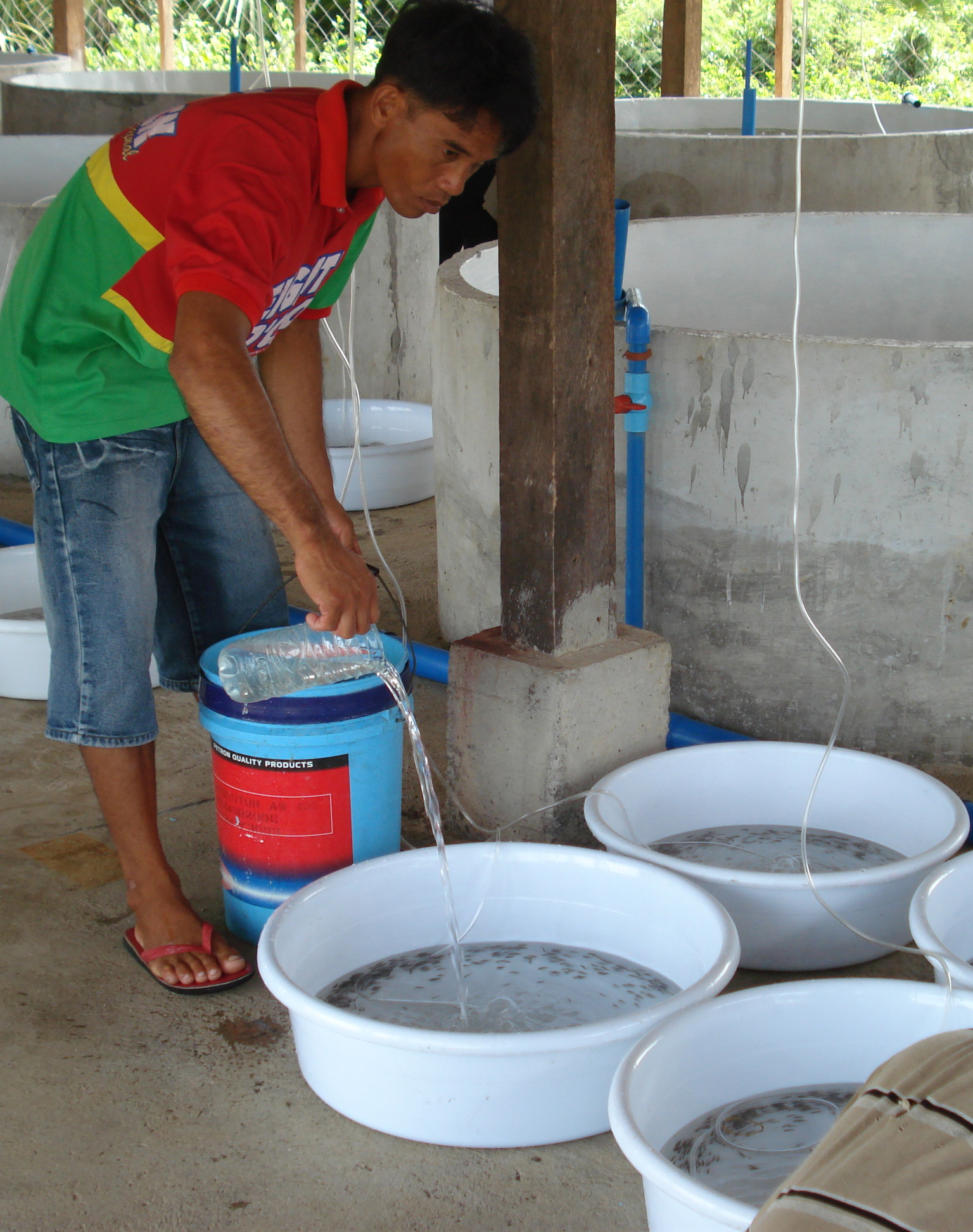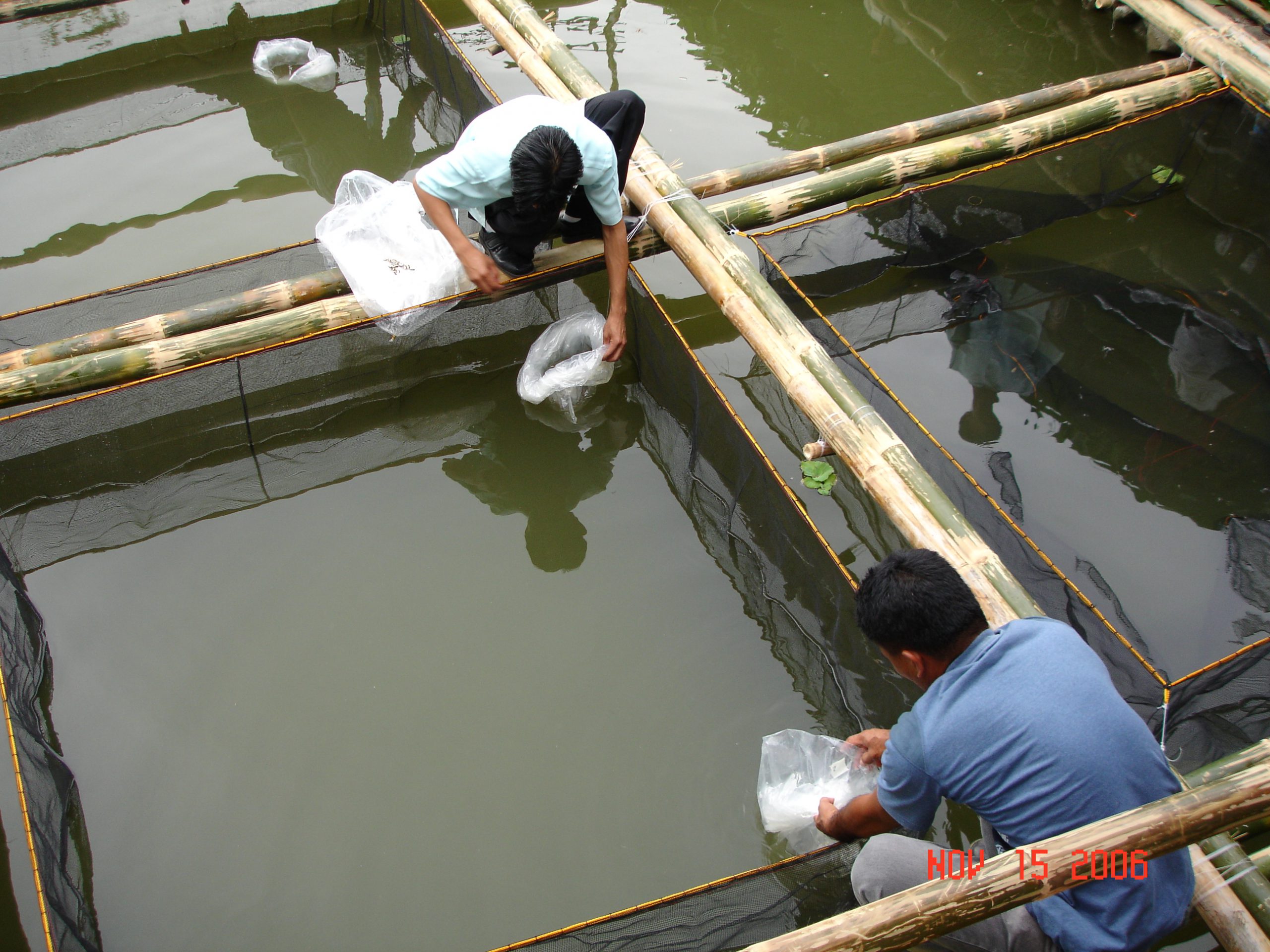Why SEA BASS?
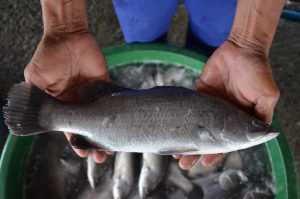
Sea bass (Lates calcarifer, giant perch or apahap) is an economically important food fish in the tropical and sub-tropical regions of Asia and the Pacific. It is a highly carnivorous fish but can be trained to feed on formulated diets. It can tolerate a wide range of salinity from freshwater to full seawater. Improved growth has been generally observed when fish is cultured at low salinity (10-20 ppt).
Sea bass is easy to culture in cages or in brackishwater ponds. It is hardy, and the seedstock can be easily sourced from the hatchery. There is a need, however, to implement a nursery before the grow-out so that sea bass can be easily sorted and size-graded to reduce competition for space and food, thus controlling cannibalism. Survival in the 45 to 50-day nursery phase can be as high as 96%. Sea bass has a high market value, particularly sold in fine dining restaurants.
How to culture SEA BASS?
Hatchery
-
Sea bass hatchery Procure sea bass breeders (2-8 kg) at a sex ratio of 1:2 female:male. Obtain egg samples by cannulation and make sure average egg diameter is at least 0.4 mm; males should give out milt. Inject with a fresh solution of LHRHa at 20-100 µg per kg of fish. Put them back to spawning tank or cage. Sea bass will spawn on the second night after injection.
- Collect and incubate eggs in tanks at 1,200 eggs per L. These hatch in about 14 hours.
- Stock 30 sea bass larvae per L in larval rearing tank (LRT) but reduce this density to 15 per L on day 10, then to 6 per L on day 21.
- Add and maintain 1-3 x 105 Chlorella cells per ml in the LRT to maintain water quality and to serve as food to rotifers. It is best to introduce live food before the sea bass larvae begin feeding 50 hours after hatching.
- Feed daily ~ Rotifer feeding is 2-3 ind/ml from day 2-5, increase to 10 ind/ml from day 5-10 and increase to 20 ind/ml from day 10-20. For Artemia, 1-2 ind/ml from day 15 until harvest (25 or 26 days). Being live feed, there is no danger in feeding these to satiation.
- Sort and size-grade every week such that there is not more than 30% size difference in one tank. Rear the shooters separately; they usually show after Artemia feeding.
- Make sure the rearing tanks are cleaned daily and the water changed.
- Harvest after 26 days of rearing.
Nursery
Phase 1
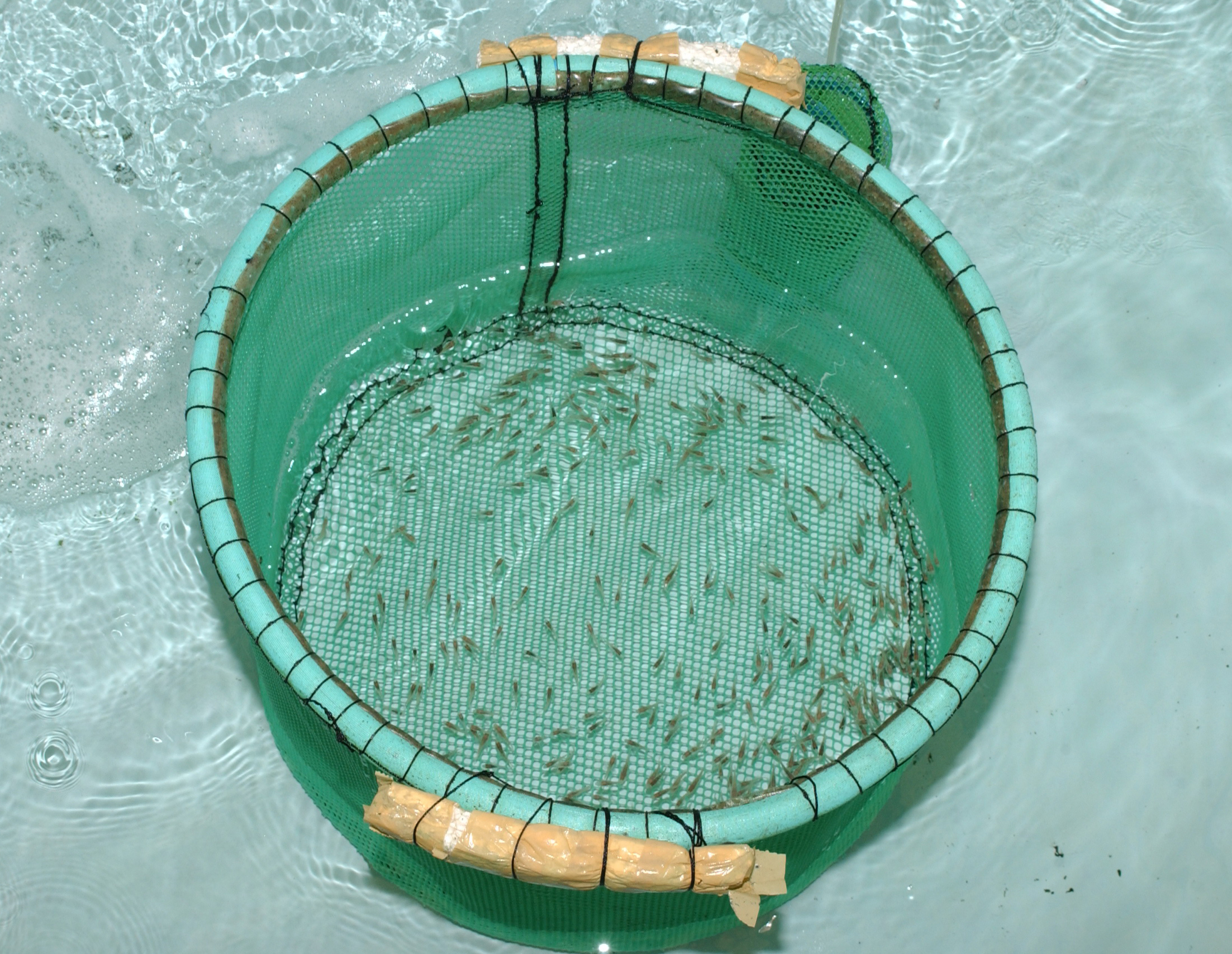
Sea bass fry can be reared in earthen ponds, land-based tanks, or in net cages (hapa) set in ponds.
- Preferably, ponds should not be more than 2,000 m2. Ponds are prepared and fertilized at least one week before stocking to eradicate predators and grow zooplankton. This phase can take 10-20 days. Fish are stocked in ponds at 1.0-1.5 cm total length. Always remember to sort and size-grade.
-
Hapa net cage set in ponds for nursery Concrete nursery tanks are 3-5 tons where fry can be weaned to formulated diet. They are fed every 2 hours, size-graded every 5-7 days and harvested or transferred at 2.5-3.0 cm total length. This can take 30 days.
- Net cages (hapa) set in ponds can measure 2 x 1 x 1 m. Optimum stocking density is 150-200 fry/m3. Fry are fed with natural zooplankton, mysids, mosquito larvae and/or formulated feed, graded every 5-7 days and harvested or transferred to B-net cage when the fry attains 2.5-3.0 cm total length. This can take 30 days.
- Light can be provided to attract zooplankton and encourage fish foraging during the night.
Phase 2
At this stage, fish juveniles are fed fish by catch or formulated feed six times per day until they reach 20-50 g, the ideal size for grow-out culture. Phase 2 nursery can be done in concrete tanks or cages in ponds.
- In concrete tanks (3-5 tons), juveniles are fed with formulated feed every 2 hours. Juveniles are graded and tanks cleaned every 5-7 days.
- In ponds, B-net cages can measure 2 x 3 x 1 m or 1 x 3 x 1 m. The same procedure is used as in the above and the fish are harvested at 7-10 cm total length.
Grow-out
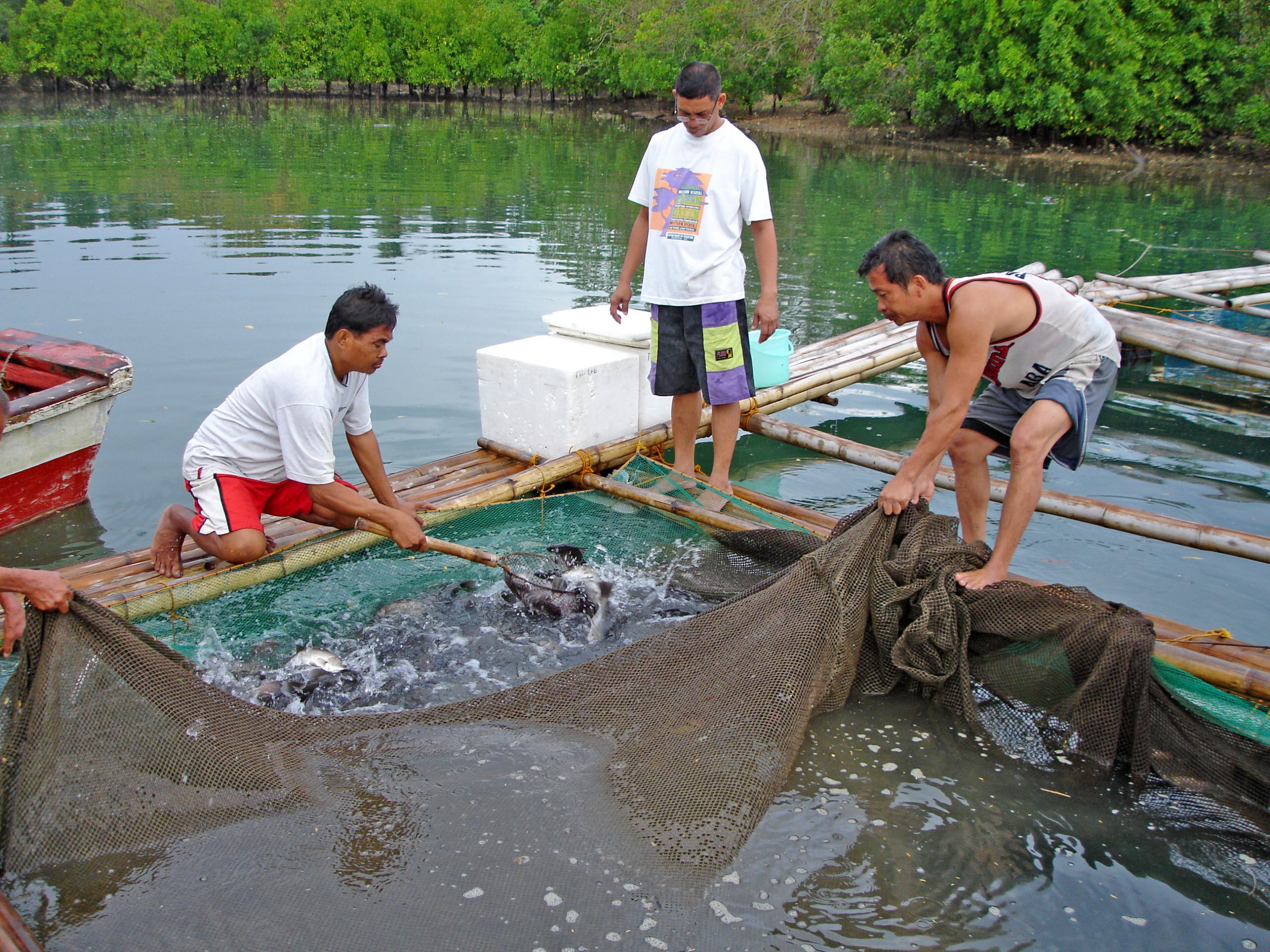
Sea bass juveniles with body weight range of 20-50 g is utilized. They are fed fish by catch at 5-10% biomass or formulated feed at 3-5% biomass given 2-3x per day. Sea bass can reach marketable size of 300-600 g in about 4-7 months. Grow-out culture can be done in ponds or cages.
- Pond culture. The recommended stocking density is 10,000 pcs/ha. Pond water should be drained and replenished for 40-60% of the volume daily.
- Cage culture. Cage size is 5 x 5 x 3 m with a recommended stocking density of 15-20 pcs/m3.
Is SEA BASS grow-out culture in ponds profitable?
Technical assumptions
| Item | |
| Area of pond (ha) | 1 |
| No. of crops per year | 1.5 |
| Days of culture per crop | 180 |
| Stocking density/ha | 10,000 |
| Total no. of fish/crop | 10,000 |
| Survival | 85% |
| Feed conversion ratio | 2.2 |
| Feed cost/yr (Php) | 695,640 |
| Cost of fingerlings/yr | 375,000 |
| Harvest weight (g/fish) | 400 |
| Production (kg/crop) | 3,400 |
| Production (kg/yr) | 5,100 |
Financial investment analysis (as of 2017)
| Item | |
| Average selling price (Php) | 260 |
| Gross sales (Php/yr) | 1,326,000 |
| Total investment cost (Php) [Paddle wheel aerators, Submersible pump, B-net, Fine Mesh and Monofilament #160] |
96,250 |
| Total operating cost per yr | 1,118,040 |
| Income per year (Php) | 207,960 |
| Return-on-investment (%) | 216.06 |
Reference:
SEAFDEC Aquaculture Department. (2017). Sea bass culture [Brochure]. Tigbauan, Iloilo, Philippines: Author.
Need ASSISTANCE?
Get a copy of our manual!
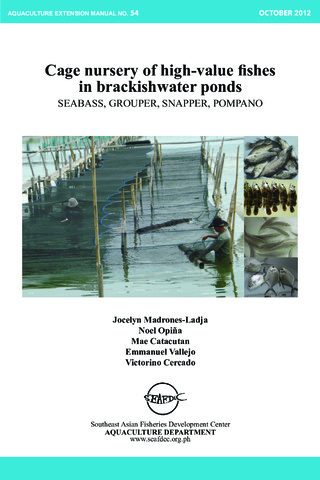 |
AEM 54 Cage nursery of high-value fishes in brackishwater ponds (sea bass, grouper, snapper, pompano) (2012) Jocelyn Madrones-Ladja et al This extension manual describes nursery pond requirements, nursery rearing procedures, common diseases of young marine fish, and economic analysis of cage nursery as an enterprise separate from hatchery and grow-out culture. Each copy costs US$5 |
| Sea bass Culture (2017) The brochure contains information on the hatchery, nursery, and grow-out culture of sea bass. |
Check out our online bookstore for more titles: www.seafdec.org.ph/bookstore
Attend our hands-on training!
Marine Fish Hatchery Operations and Hatchery of Selected Marine Species (Milkfish/Sea bass/Grouper) training course at SEAFDEC/AQD’s Tigbauan Main Station.
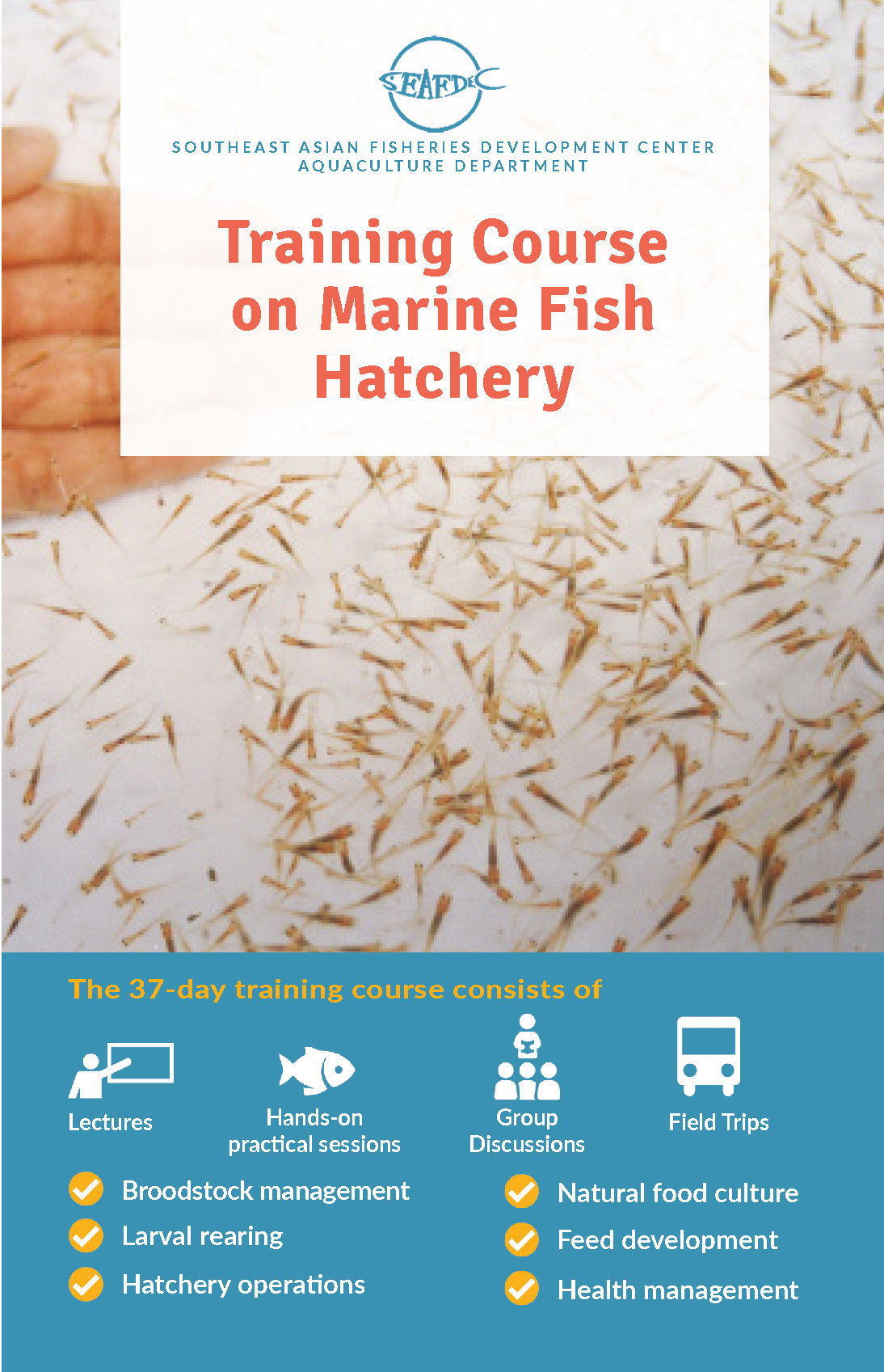 |
| View training brochure |
To apply, kindly contact:
Training and Information Division
(63-33) 330 7030
training@seafdec.org.ph
Check out our training schedule: www.seafdec.org.ph/training
